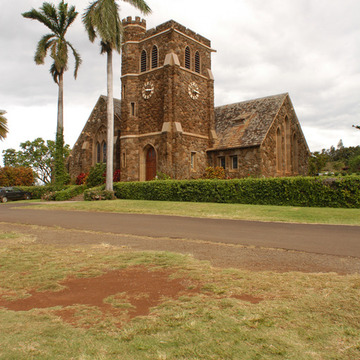A succinct, yet bold, embodiment of Gothic Revival, this church was one of the earliest Western buildings in Hawaii to use local basalt as a building material, albeit as a veneer. Constructed of reinforced concrete, the edifice stands as a memorial to Henry Perrine Baldwin, cofounder of Alexander and Baldwin and one of the preeminent figures in the history of sugar in Hawaii. From the steep, slate-covered gabled roof, massive Norman tower, and recessed lancet windows to the dark interior with its tracery, paneled walls, open-truss ceiling, and stained glass windows, the building epitomizes, for Maui, the aura of the Gothic era. The four memorial windows date from 1889 and were transferred from an earlier church. The vestibule is floored with two different marbles.
Makawao Union Church was established by the Reverend Jonathan Green to meet the spiritual needs of the English-speaking foreign community in the Makawao area. It was chartered in 1861, with an initial church built at the present site of the Makawao cemetery. In 1888, Henry Perrine Baldwin, who was a missionary's son, donated this site to the church and a building was erected on the foundations of his former sugar mill. The present memorial church replaced that earlier frame structure. Fittingly, C. W. Dickey was a nephew of Henry Perrine Baldwin.















